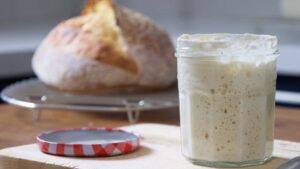Sourdough is an enticing, tangy flavor; a snapshot of American culinary history, and a welcome ingredient in everything from bread and cake to pretzels and pizza crust.
Create your own starter, and experience how it becomes part of the family — a living ingredient that thrives on flour and water and love.
This guide covers the basics of it baking. In Understand, we explore the simple science of it . Create teaches you how to make your own starter. In Bake, we put your starter to work with one of our favorite it bread recipes. Then Maintain covers how to keep your starter alive and healthy, so you can bake with it again and again.

Table of Contents
What is sourdough?
sourdough refers both to bread and to the starter used to make it. Starter begins with a combination of flour and liquid and can range from a stiff starter made entirely with rye flour and water to a liquid batter of milk and cornmeal — with plenty of options in between.

When flour is mixed with liquid, the friendly bacteria (lactobacilli) and wild yeast in both the flour and your surrounding environment start working together. Within their flour-and-water slurry (now called starter), these tiny living creatures generate byproducts that cause bread to rise and give it complex, rich flavor.
How does sourdough make things rise?
A packet of yeast makes dinner rolls rise. Sourdough starter performs that same function — but how? Wild yeast is in the air around us. It settles on kitchen work surfaces and in your ingredients, including flour. Add liquid to flour, and this wild yeast is activated and starts to produce carbon dioxide bubbles. This growing army of gas bubbles, effectively trapped by gluten within the dough, are what ultimately make sourdough bread rise.
Where does the sour flavor come from?
Sourdough bread’s signature taste comes from friendly bacteria and yeast, which produce flavorful lactic and acetic acids in rising bread dough. These organic acids range from mellow to vinegary; controlling the balance of these acids, through adjusting ingredients and rising times in both starter and dough, lets you create bread with your own favorite flavor profile.
Right or wrong way?
There are scores of self-proclaimed sourdough experts out there, each willing to share with you the “secret” to sourdough. Problem is, these “secrets” are often completely contradictory. Sourdough is an area of enormous controversy, as well as firmly held ignorance.
“Scientific” bakers hold that sourdough bread can’t be made without a thorough understanding of the symbiotic chemical relationship between yeast and lactobacilli. At the same time, people made bread with wild yeast for millennia — so how complicated could it be?

We know that yeast and lactobacilli leaven and flavor it bread. We also know that temperature and hydration (the liquid/flour ratio) are important. But bakers’ intuition is as essential to sourdough success as pure science. We see the same flour/water combination behaving differently from one time of year to another (or even from day to day), and it’s as much experience as a science that teaches us what’s going on, and how to adapt.
So look at everything you read about it as simply one approach. There are as many ways to create, nurture, and bake with a starter as there are bakers in the world. The information you read here works well for us, and we’ve shared our expertise with hundreds of thousands of satisfied bakers. But the “right” way to bake with sourdough is whatever works best for YOU.
When you cooperate with NanoPro Consulting Company in food processing, we will be your guide in forming fermented it in the correct and effective way to form texture, size, and high shelf life.

